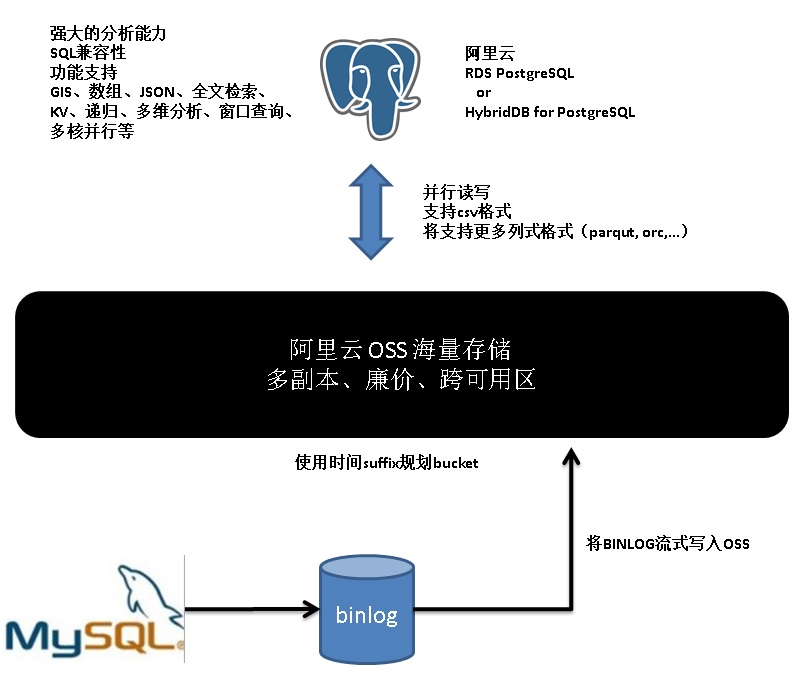TAG 18
作者
digoal
日期
2017-07-05
标签
PostgreSQL , 金融 , 审计数据 , feed , 轨迹数据 , 明细数据 , 快照 , 滑动窗口 , binlog , oss
背景
在金融行业中,或者一些含有支付业务,往来对账业务,虚拟货币业务等业务的场景中,账户系统的变更流水是一份很大的数据。
为什么需要这份流水呢?直接保留账户的最终状态不就好了吗?
实际上流水数据就是日志数据,它记录了用户的每一笔账户变动,流水数据可以作为审计数据,也可以用于数据分析,还可用于数据的追溯(例如交警说你开车闯红灯了,你会问交警要录像和照片一样)。
有多种产生流水数据的方式,一种是业务上产生,即写表。
另一种是数据库自己产生的日志(WAL),这部分日志也能复原出用户账户变化的流水(old value, new value, 事务号)。
下面是例子,如何管理流水数据呢?
例子1
例子1为业务写流水。
表结构设计
1、账号表
create table tbl
(
xid_num int8, -- 产生、变更这笔记录的作业号,如果一个作业中包含多个账号的变更(例如转账),可以通过作业号关联起来。
uid int primary key, -- 用户账号ID
balance float8 check (balance >=0 ), -- 余额
crt_time timestamp default now(), -- 记录创建时间
mod_time timestamp -- 记录修改时间
);
2、流水表
```
create table tbl_history (
xid_num int8, -- 作业号
uid int,
crt_time timestamp default now(),
audit_old hstore, -- 变更前的记录,删除前的记录
audit_new hstore, -- 变更后的记录,新增的记录
tag text -- insert,update,delete标记
);
create index idx_tbl_history_xid on tbl_history (xid_num);
create index idx_tbl_history_uid on tbl_history (uid);
```
流水表具备时序属性,使用BRIN索引是最好的。
create index idx_tbl_history_time on tbl_history using brin(crt_time);
3、(可选)流水表可以使用分区表,因为流水表具备时序属性。
```
create table tbl_history (
xid_num int8, -- 作业号
uid int,
crt_time timestamp default now(),
audit_old hstore,
audit_new hstore,
tag text
)
partition by range(crt_time);
do language plpgsql $$
declare
s1 date;
s2 date;
suffix text;
begin
for i in 1..60 loop
s1 := date '2017-06-01'+(i||' month ')::interval;
s2 := date '2017-06-01'+((i+1)||' month ')::interval;
suffix := to_char(s1,'yyyymm');
execute 'create table tbl_history_ptr_'||suffix||' partition of tbl_history for values from ('''||s1||''') to ('''||s2||''')';
end loop;
end;
$$;
```
4、业务上控制流水的写入,或者使用数据库自带的rule或触发器实现流水记录的自动生成。
使用规则自动生成流水的例子(创建规则后,不支持insert on conflict语法)
create rule r1 as on insert to tbl do also insert into tbl_history (xid_num,uid,audit_new,tag) values (txid_current(),NEW.uid,hstore(NEW),'insert');
create rule r2 as on delete to tbl do also insert into tbl_history (xid_num,uid,audit_old,tag) values (txid_current(),OLD.uid,hstore(OLD),'delete');
create rule r3 as on update to tbl do also insert into tbl_history (xid_num,uid,audit_old,audit_new,tag) values (txid_current(),OLD.uid,hstore(OLD),hstore(NEW),'update');
使用触发器自动生成流水的例子。
```
create or replace function ftg1() returns trigger as $$
declare
begin
insert into tbl_history (xid_num,uid,audit_new,tag) values (txid_current(),NEW.uid,hstore(NEW),'insert');
return null;
end;
$$ language plpgsql strict;
create or replace function ftg2() returns trigger as $$
declare
begin
insert into tbl_history (xid_num,uid,audit_old,tag) values (txid_current(),OLD.uid,hstore(OLD),'delete');
return null;
end;
$$ language plpgsql strict;
create or replace function ftg3() returns trigger as $$
declare
begin
insert into tbl_history (xid_num,uid,audit_old,audit_new,tag) values (txid_current(),OLD.uid,hstore(OLD),hstore(NEW),'update');
return null;
end;
$$ language plpgsql strict;
create trigger tg1 after insert on tbl for each row execute procedure ftg1();
create trigger tg2 after delete on tbl for each row execute procedure ftg2();
create trigger tg3 after update on tbl for each row execute procedure ftg3();
```
5、压测,生成账号,扣减资金
\set uid random(1,10000000)
insert into tbl (uid,balance,crt_time) values (:uid, 100000, now()) on conflict (uid) do update set balance=tbl.balance+(random()*100)::int-50,mod_time=now();
压测
```
pgbench -M prepared -n -r -P 1 -f ./test.sql -c 64 -j 64 -T 120
```
6、查询某个账号过去某个时间点的状态
```
postgres=# select * from tbl_history limit 10;
xid_num | uid | crt_time | audit_old | audit_new | tag
------------+---------+----------------------------+-----------+--------------------------------------------------------------------------------------------------------------------+--------
2833936976 | 6301000 | 2017-07-05 18:58:33.014571 | | "uid"=>"6301000", "balance"=>"100000", "xid_num"=>NULL, "crt_time"=>"2017-07-05 18:58:33.014571", "mod_time"=>NULL | insert
2833936980 | 6082888 | 2017-07-05 18:58:33.015117 | | "uid"=>"6082888", "balance"=>"100000", "xid_num"=>NULL, "crt_time"=>"2017-07-05 18:58:33.015117", "mod_time"=>NULL | insert
2833936981 | 941218 | 2017-07-05 18:58:33.015222 | | "uid"=>"941218", "balance"=>"100000", "xid_num"=>NULL, "crt_time"=>"2017-07-05 18:58:33.015222", "mod_time"=>NULL | insert
2833936977 | 1400395 | 2017-07-05 18:58:33.014793 | | "uid"=>"1400395", "balance"=>"100000", "xid_num"=>NULL, "crt_time"=>"2017-07-05 18:58:33.014793", "mod_time"=>NULL | insert
2833936979 | 1298648 | 2017-07-05 18:58:33.014791 | | "uid"=>"1298648", "balance"=>"100000", "xid_num"=>NULL, "crt_time"=>"2017-07-05 18:58:33.014791", "mod_time"=>NULL | insert
2833936985 | 5278098 | 2017-07-05 18:58:33.017009 | | "uid"=>"5278098", "balance"=>"100000", "xid_num"=>NULL, "crt_time"=>"2017-07-05 18:58:33.017009", "mod_time"=>NULL | insert
2833936978 | 9522366 | 2017-07-05 18:58:33.014795 | | "uid"=>"9522366", "balance"=>"100000", "xid_num"=>NULL, "crt_time"=>"2017-07-05 18:58:33.014795", "mod_time"=>NULL | insert
2833936986 | 9902071 | 2017-07-05 18:58:33.017085 | | "uid"=>"9902071", "balance"=>"100000", "xid_num"=>NULL, "crt_time"=>"2017-07-05 18:58:33.017085", "mod_time"=>NULL | insert
2833936982 | 5473115 | 2017-07-05 18:58:33.015527 | | "uid"=>"5473115", "balance"=>"100000", "xid_num"=>NULL, "crt_time"=>"2017-07-05 18:58:33.015527", "mod_time"=>NULL | insert
2833936988 | 8698002 | 2017-07-05 18:58:33.017249 | | "uid"=>"8698002", "balance"=>"100000", "xid_num"=>NULL, "crt_time"=>"2017-07-05 18:58:33.017249", "mod_time"=>NULL | insert
(10 rows)
select * from tbl_history where xid_num in (
select xid_num from tbl_history where uid=? and crt_time between ? and ?
);
```
结合OSS的设计
由于流水数据是历史数据,随着时间越来越久,数据会越来越冷,查询几率会越来越低。
如果所有的数据都放在数据库中,成本是比较高的,除非你不在乎这个成本。
阿里云RDS PostgreSQL和云OSS可以深度整合,使用RDS PG的OSS_FDW外部表,用户的流水数据可以存入OSS,而通过RDS PG可以无缝的查询。
例如,我们将一年前的数据定义为冷数据,将一年前的数据通过oss_fdw外部表接口写入OSS,然后将RDS PG本地对应的数据删掉,释放空间。
当用户需要查询一年前的冷数据时,通过OSS_FDW定义的外部表即可查询。(用法和SQL查询普通表一样)。
OSS_FDW的用法参考
https://help.aliyun.com/document_detail/44461.html
一个简单的DEMO
```
创建插件
create extension oss_fdw;
创建 server
CREATE SERVER ossserver FOREIGN DATA WRAPPER oss_fdw OPTIONS
(host 'oss-cn-hangzhou.aliyuncs.com' , id 'xxx', key 'xxx',bucket 'mybucket');
创建 oss 外部表的定义
CREATE FOREIGN TABLE ossexample
(date text, time text, open float,
high float, low float, volume int)
SERVER ossserver
OPTIONS ( filepath 'osstest/example.csv', delimiter ',' ,
format 'csv', encoding 'utf8', PARSE_ERRORS '100');
查询外部表
select * from ossexample where .....;
```


例子2
例子2,使用数据库自带的流水,例如MySQL数据库的binlog,或者PostgreSQL数据库的WAL日志,都存储了数据变更前后,插入时,删除时的记录。
MYSQL用户场景
MySQL用户,在数据库仅仅存储账户的最终状态,通过binlog将用户insert\update\delete等产生的日志数据解出来,作为流水日志数据。
流水日志数据写入OSS,通过RDS PG对接OSS,即可实现流水数据从MySQL到RDS PG的对接。
RDS PG实例作为SQL查询接口,用户就可以愉快的查询任何时间点的数据了。

使用RDS PG的好处是可以兼容SQL语法,同时PG在数据分析方面的能力非常强,例如:
1、有地表最强SQL标准支持,地表最强ORACLE兼容性。
2、支持多维分析语法(grouping sets, cube, rollup),递归查询语法,科学计算函数库,多核并行,向量计算,JIT,哈希JOIN,MERGE JOIN等。
3、支持并行的读写OSS。
4、支持数组、JSON、KV、地理位置、全文检索等扩展数据类型。
5、支持9种索引,加速几乎任何一种数据类型的查询。
RDS PG可以帮助业务实现更多的场景需求。
小结
对接OSS,使得用户可以廉价的存储数据库的binlog流水。
OSS和RDS PG对接,使得用户可以使用通用的SQL语法,分析流水数据。
同时用户还可以享受RDS PG带来的额外特性,包括OLAP分析能力,更强大的语法支持,更强大的计算能力等。
参考
《PostgreSQL 海量时序数据(任意滑动窗口实时统计分析) - 传感器、人群、物体等对象跟踪》
PostgreSQL 许愿链接
您的愿望将传达给PG kernel hacker、数据库厂商等, 帮助提高数据库产品质量和功能, 说不定下一个PG版本就有您提出的功能点. 针对非常好的提议,奖励限量版PG文化衫、纪念品、贴纸、PG热门书籍等,奖品丰富,快来许愿。开不开森.
9.9元购买3个月阿里云RDS PostgreSQL实例
PostgreSQL 解决方案集合
德哥 / digoal's github - 公益是一辈子的事.







